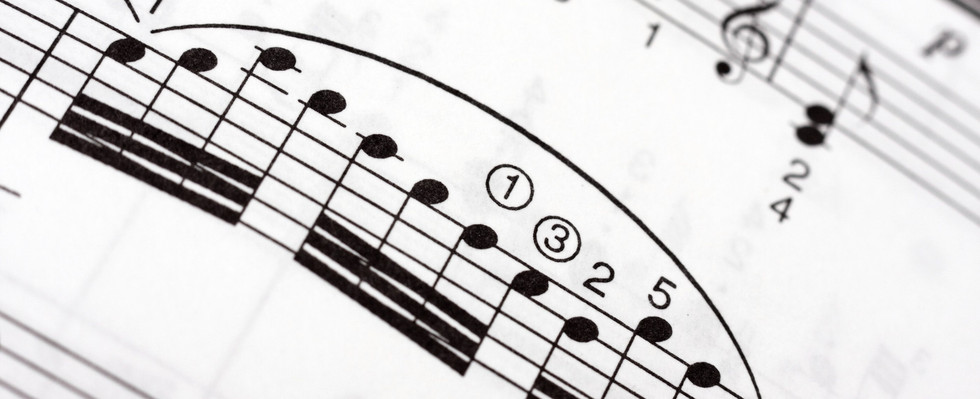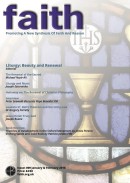Music and the Liturgy
Joseph A. Estorninho FAITH MAGAZINE January - February 2016
Joseph A. Estorninho looks at music and explores the specific bonds that link chant to the Eucharist
In its essence music is an aural experience. All music shares common elements,dealing with sound: pitch (how high or low), dynamics (how loud or soft), rhythm (the combination of long and short sounds), tempo (how fast or slow) and timbre (the sound produced by combinations of different instruments). In the Western musical tradition these can all be written using a common method known as staff notation. But music has different uses and functions.
Music and Liturgy
In order to understand liturgical music we must understand the dichotomy of the world in which it exists. There is a fundamental confusion, because of the terminology that is used. The label ‘music’ is attached to the singing of the Mass. But although the music of the Mass shares the commonality of the elements of music it is, in every other aspect, different.
The distinction must be clarified in order for us to properly engage with liturgical music, which is a distinct phenomenon used to one end only: to serve God in the celebration of the Holy Eucharist.
Music, in the secular world, is an entertainment, a diversion, which is not to say that it is of a lesser value – after all, the gifts bestowed on the musicians come directly from God. It merely means that this music directs our minds in a particular way: our own appreciation of it. It is about how we react to the sounds, our understanding of the genius of the composer or performers, or how we are affected emotionally. It is, in effect ego-centric.
Secular Music
Secular music is influenced by philosophical and artistic fashions, not to mention mechanical and technological advances. Fashion is by its very definition impermanent: it is replaced at an ever increasing speed. In both clothing and music it relies economically on its constant re-invention.
In this world music is sometimes superfluous, unheard and sometimes specifically designed to be so. Music in films is seldom consciously heard - its purpose is to underline drama and to bring to the fore what cannot be expressed in dialogue or action. The same is true of music in computer games. Music piped through shopping centres is like this too, designed to penetrate our psyche, encouraging us to or spend more: its existence is not reliant on us consciously listening to it.
For the first time in history we have music specifically designed not to be heard, for which composers and performers are being paid handsomely.
Then we have the music of concerts or theatre – music that is designed to be heard. In the concert hall it is exclusive; the only purpose is appreciation of the aural experience. In the theatre we acknowledge the presence of music, although its function can also reflect that of film music. In both these instances the performers’ sole objective is to provide an entertainment for the audience and when it is done well we applaud.
And we have music to facilitate dancing: designed to be heard, although today this is only an assumption based on the deafening volume of the music within some clubs.
Liturgical music
The music of the liturgy is not subject to fashion; it is timeless and it is as ageless as the faith. It does not exist make us feel good about ourselves. It is not performance, we are not at a concert and we do not applaud the schola, the choir or the organist after the Mass and they do not take a bow. “Wherever applause breaks out in the liturgy because of some human achievement, it is a sure sign that the essence of liturgy has totally disappeared and been replaced by a kind of religious entertainment.”
Because we call it ‘music’ and place it with other forms of music, we may begin to apply the norms of musical performance. We expect that any instruments are appropriate for the Mass, we expect to be entertained and diverted. But these are all erroneous expectations and have no place in the Mass, which is not about us but about the supreme sacrifice of Christ.
This fundamental misinterpretation and misguided perception of the music of the sacred liturgy that is leading us down the path towards ever more fashionable styles of music being introduced to the Eucharist.
The Nature of the Eucharist
The singing of the liturgy serves the divine nature of the Eucharist: it communicates words that are too beautiful and incomprehensible to be merely spoken. In singing, we can elevate the mundane to the extraordinary; something more fitting as an offering to the Divine. We lift up our voices in joy and thanksgiving for the graces bestowed on us by a loving Father.
Gregorian chant is not entertainment and a poor choice for dancing. Where it holds its own is in the sacred liturgy, exactly because it cannot be confused with music of other styles. It does not lead us to look inwardly to our own values of music appreciation but rather focuses our attention on the text, which is of prime importance:
Chant, is uniquely liturgical and Gregorian chant, in particular, is the music of the Roman rite. Its history predates Christ on earth: the chanting of sacred Scripture is a tradition we have inherited from the Jews. Luke’s gospel recounts that Jesus read the Holy Scriptures in the synagogue: “He came to Nazareth…and went to the synagogue on the Sabbath day, as he usually did. He stood up to read, and they handed him the scroll of Isaiah.” What will not be immediately obvious to the modern reader but which the evangelist assumed his contemporaries would understand, however, is that these scriptures were chanted.
The text of the Mass is of the utmost importance. It is how we attempt to understand the incomprehensible. Gregorian chant is not reliant on the rhythms imposed by bar lines and other artificial stresses: it is driven by the text and subjugates itself to that text.
Other Styles
On the other hand we have Masses of a more recent style in which the text has been subjugated to the music. The text has been chopped up and shoehorned into the music like a size 10 foot forced into a size 5 shoe. The result cannot be a happy one.
The text of the ‘Sanctus’ is at first glance quite an uncomplicated one. It is undoubtedly a descendant of the Jewish Kadosh, Kadosh, Kadoshand its ensuing lines from the Kedusha. The first two lines of the prayer are:
Holy, Holy, Holy Lord God of hosts.
Heaven and earth are full of your glory.
Beautiful in its simplicity: the word ‘Holy’ sung three times just as in the Hebrew setting, but in this instance and in the context of the Eucharist its significance is even more poignant. The phenomenon of threes happens all through the Mass; three lines in the Kyrie, three ‘Alleluias’, three lines in the Agnus Dei and the Gloria is full of them. These threes are not accidental – they lead us to focus on the Trinity.
One setting in particular makes this incomprehensible. This is a setting of the Sanctus that I heard at Mass just last Sunday:
Holy, Holy, Holy Lord, Holy, Holy Lord God of hosts, Heaven and earth, Heaven and earth are full of your glory Lord God of hosts.
I must apologise for not writing it as a verse, but the simple fact is that I cannot decide where to divide the lines. The thrice sung ‘Holy’ is here accompanied by two more; the phrase ‘Lord God of hosts’ is cut to separate the word ‘Lord’, which, seemingly ends the first phrase ‘Holy, Holy, Holy’ and separates it from the other two, but the entire phrase appears twice, the second of which seems to be completely random; the phrase ‘Heaven and earth’ is repeated in quick succession and to what end is not clear.
This most beautiful hymn of praise sung by the hosts of Heaven has become a mish-mash of words. If the words are so mixed up as to be incomprehensible how are we to understand their meaning, and if we cannot do that how can we claim to be fully participating in the Mass? Settings such as this deny us the full and active participation in the Mass to which we are all called.
Timeless
Overdependence on the rhythmic structures of the music rather than on the text is a problem exclusive to more recent styles of music. The text of the Mass has its own innate rhythmic structure and it is this that Gregorian chant facilitates. Because Gregorian chant lacks the regular rhythmic stresses and accents, it relies on these aspects of the text to give it impetus. The notation of Gregorian chant betrays very little in the way of rhythm, which is left to the nuances in the text.
The fashion that brought the so-called “folk” Masses into being has now long gone, together with the flared trousers and peace signs that adorned camper vans, and that style has been superseded by another style, which in its turn will be forgotten.
Many of the hymns of the 1960s and 1970s are no longer heard and that the many newer ones that have replaced them may enjoy the same fate. This is the way of fashion and if we subject ourselves to fashion we must live and die by it.
St Augustine wrote in his ‘Confessions’ “I was deeply moved by the sweet chants of your church”; they were still being sung in the churches 700 years later during the Norman invasion; they were still being sung in the priest holes of England in the seventeenth century; these same chants were sung at Masses celebrated during two world wars. It is not a slave to fashion. The timelessness of Gregorian chant is not subject to the frivolities or fickleness of fashion making it the perfect music for a timeless church.






